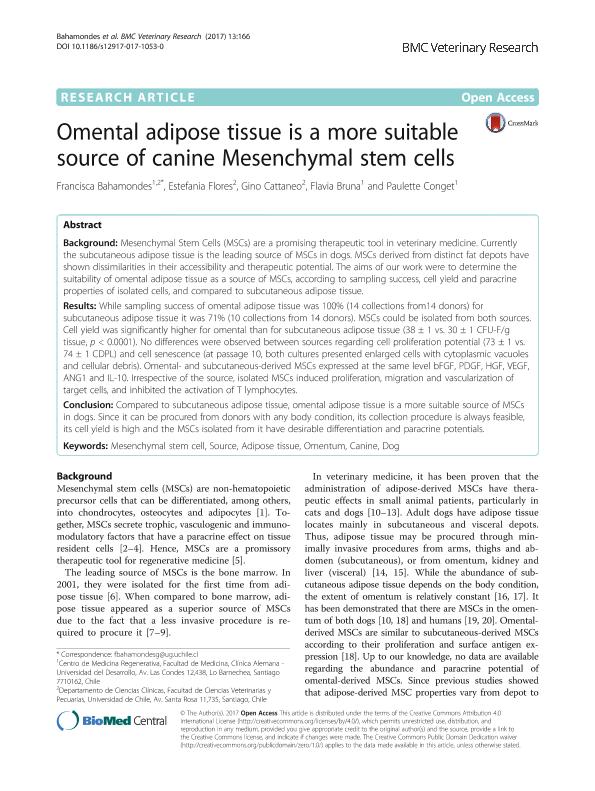Mostrar el registro sencillo del ítem
dc.contributor.author
Bahamondes, Francisca
dc.contributor.author
Flores, Estefania
dc.contributor.author
Cattaneo, Gino
dc.contributor.author
Bruna, Flavia Alejandra

dc.contributor.author
Conget, Paulette
dc.date.available
2018-06-26T22:04:26Z
dc.date.issued
2017-06
dc.identifier.citation
Bahamondes, Francisca; Flores, Estefania; Cattaneo, Gino; Bruna, Flavia Alejandra; Conget, Paulette; Omental adipose tissue is a more suitable source of canine Mesenchymal stem cells; BioMed Central; BMC Veterinary Research; 13; 1; 6-2017; 1-9
dc.identifier.issn
1746-6148
dc.identifier.uri
http://hdl.handle.net/11336/50191
dc.description.abstract
Background: Mesenchymal Stem Cells (MSCs) are a promising therapeutic tool in veterinary medicine. Currently the subcutaneous adipose tissue is the leading source of MSCs in dogs. MSCs derived from distinct fat depots have shown dissimilarities in their accessibility and therapeutic potential. The aims of our work were to determine the suitability of omental adipose tissue as a source of MSCs, according to sampling success, cell yield and paracrine properties of isolated cells, and compared to subcutaneous adipose tissue. Results: While sampling success of omental adipose tissue was 100% (14 collections from14 donors) for subcutaneous adipose tissue it was 71% (10 collections from 14 donors). MSCs could be isolated from both sources. Cell yield was significantly higher for omental than for subcutaneous adipose tissue (38 ± 1 vs. 30 ± 1 CFU-F/g tissue, p < 0.0001). No differences were observed between sources regarding cell proliferation potential (73 ± 1 vs. 74 ± 1 CDPL) and cell senescence (at passage 10, both cultures presented enlarged cells with cytoplasmic vacuoles and cellular debris). Omental- and subcutaneous-derived MSCs expressed at the same level bFGF, PDGF, HGF, VEGF, ANG1 and IL-10. Irrespective of the source, isolated MSCs induced proliferation, migration and vascularization of target cells, and inhibited the activation of T lymphocytes. Conclusion: Compared to subcutaneous adipose tissue, omental adipose tissue is a more suitable source of MSCs in dogs. Since it can be procured from donors with any body condition, its collection procedure is always feasible, its cell yield is high and the MSCs isolated from it have desirable differentiation and paracrine potentials.
dc.format
application/pdf
dc.language.iso
eng
dc.publisher
BioMed Central

dc.rights
info:eu-repo/semantics/openAccess
dc.rights.uri
https://creativecommons.org/licenses/by-nc-sa/2.5/ar/
dc.subject
Adipose Tissue
dc.subject
Canine
dc.subject
Dog
dc.subject
Mesenchymal Stem Cell
dc.subject
Omentum
dc.subject
Source
dc.subject.classification
Otras Ciencias Veterinarias

dc.subject.classification
Ciencias Veterinarias

dc.subject.classification
CIENCIAS AGRÍCOLAS

dc.title
Omental adipose tissue is a more suitable source of canine Mesenchymal stem cells
dc.type
info:eu-repo/semantics/article
dc.type
info:ar-repo/semantics/artículo
dc.type
info:eu-repo/semantics/publishedVersion
dc.date.updated
2018-06-18T19:10:41Z
dc.journal.volume
13
dc.journal.number
1
dc.journal.pagination
1-9
dc.journal.pais
Reino Unido

dc.journal.ciudad
Londres
dc.description.fil
Fil: Bahamondes, Francisca. Universidad de Chile; Chile. Universidad del Desarrollo; Chile
dc.description.fil
Fil: Flores, Estefania. Universidad de Chile; Chile
dc.description.fil
Fil: Cattaneo, Gino. Universidad de Chile; Chile
dc.description.fil
Fil: Bruna, Flavia Alejandra. Universidad del Desarrollo; Chile. Consejo Nacional de Investigaciones Científicas y Técnicas. Centro Científico Tecnológico Conicet - Mendoza. Instituto de Medicina y Biología Experimental de Cuyo; Argentina
dc.description.fil
Fil: Conget, Paulette. Universidad del Desarrollo; Chile
dc.journal.title
BMC Veterinary Research

dc.relation.alternativeid
info:eu-repo/semantics/altIdentifier/doi/http://dx.doi.org/10.1186/s12917-017-1053-0
dc.relation.alternativeid
info:eu-repo/semantics/altIdentifier/url/https://bmcvetres.biomedcentral.com/articles/10.1186/s12917-017-1053-0
Archivos asociados
